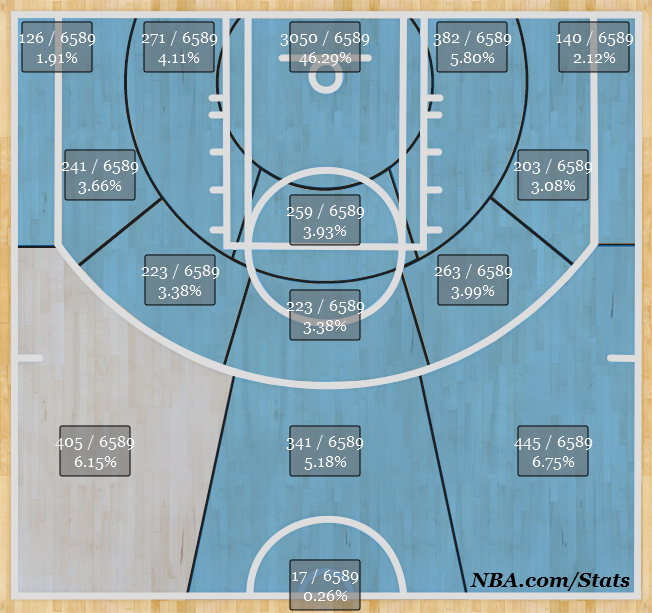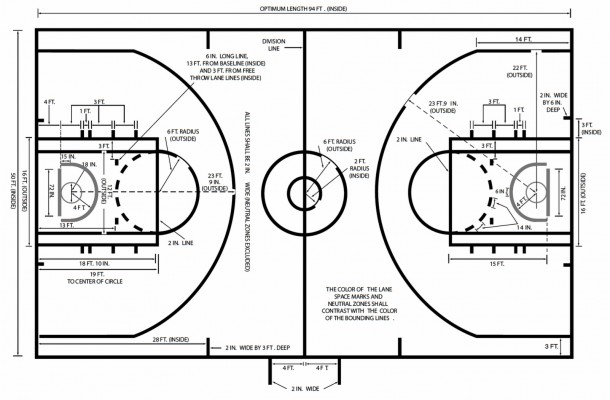Since the 2013 NBA finals ended, much has been written about floor spacing and how important it is to NBA offenses. People look at the 3-point specialists of both the Spurs and Heat and talk about how these players are vital to spreading out a defense, making these shooters critical to their team’s success.
With the Pelicans’ busy offseason of acquiring both Jrue Holiday and Tyreke Evans to pair with Eric Gordon (and to a lesser extent, Austin Rivers, Brian Roberts and Pierre Jackson), three attacking guards, there is a growing concern over the Pelicans’ floor spacing. Before, and even after, the Anthony Morrow signing the concern was the team doesn’t have enough outside shooting to play the attractive — and successful — style of basketball we saw in the Finals.
Holiday, Evans and Gordon are all rim-attacking guards; when they are on the court together, who, other than Ryan Anderson, will receive the kickout passes once defenses collapse? When all three are out there with Anthony Davis (or Greg Steimsma or Jeff Withey . . . or Greg Oden), the paint will be too crowded for to have them drive into the paint! There is only one ball for three ball-handling guards! And on and on.
But it’s all a myth — for a multitude of reasons.
Before going any further I want you to get the notion that 3-point shooters are not the only way to spread out a defense. Sure it absolutely helps — we saw that in the finals — but there are other ways to achieve effective results. John Schuhmann has a great piece about how the Heat’s floor spacing is really effective because of how they position their bigs. After pointing out that the Heat’s deep shooters weren’t hurting the Pacers in the Eastern Conference Finals, Schumann says,
And then there’s Chris Andersen, who is a perfect 13-for-13 in the series. All 13 of his baskets have come from the restricted area, lay-ups, dunks and tip-ins. But those buckets have been made possible by Andersen’s initial position on those plays.
Three seconds before Andersen’s first basket of the series, he was standing about 20 feet from the rim. In fact, he had been standing there for 10 seconds as his teammates ran a couple of pick-and-rolls and moved the ball around the perimeter.
Andersen is no threat to shoot from out there. In 54 games with the Heat, he’s 5-for-15 from outside the paint. So Hibbert doesn’t have to venture out there to defend him. But Andersen’s positioning gives his teammates a passing lane when they penetrate and draw Hibbert’s attention.
If Andersen is closer to the basket (or if he’s the roll man in a pick-and-roll), Hibbert has the length and smarts to challenge the ball-handler and cut off the passing lane at the same time. But by pacing the floor so much, the Heat’s bigs force Hibbert to make a difficult choice.
A good coach can spread out a defense though court positioning. I don’t expect Holiday, Evans and Gordon to spend a ton of time together on the floor — most likely we’ll see that lineup in crunch time. But when they are, they aren’t all going to be just standing in the paint together hanging out with Davis. There will be lanes for them to dribble into.
Look at New Orleans’ shot chart from last season.  Obviously most of the team’s looks come inside the paint, but other than behind the three point line, the next two most-shot-from locations are on the left and right block.
Obviously most of the team’s looks come inside the paint, but other than behind the three point line, the next two most-shot-from locations are on the left and right block.
Davis has flashed some range on his jump shot, and defenses will have to respect that as he develops more consistency with it. Davis has also show a great ability to run along the baseline looking to receive a short little pass and put up a shot from the end of the paint. Those looks will continue to be there, and we’ll probably see more of them when paired with guys who are threats to get to the rim whenever they want. One thing you often hear from coaches in all sports is to defend the interior — Pelicans fans saw this first hand last year with the horrific defense. Defenders will have to rotate to try to stop a layup, and it will create open looks for other teammates on the blocks.
While I like the signing of Morrow, I don’t imagine he’ll be getting a ton of minutes per game. Anyone who had concerns about the Pelicans’ shooting before shouldn’t be fooled into thinking Morrow fixes all of that. But, as I said before, I think the team’s lack of shooting is a bit of a myth. It’s been pointed out before that Holiday is a strong spot-up 3-point shooter hitting 48.1% of his attempts. Playing with Gordon or Evans, you can be sure he’ll see plenty of those spot-up 3 opportunities.
Oh, and let’s not forget that Anderson is still here. Even if the ‘rumored’ trade for Omer Asik went through, Monty is absolutely capable of running an effective offense without great 3-point shooters. Reread my post from last year on the inverted offense Monty ran. There is no shooter on the court to spread this defensel instead there is tremendous positioning to manufacture good looks for the offense.
Monty has a reputation as being a defensive coach, but if you really watch his offense there are some sneaky good sets. For the first time, he has perimeter players with (as Gerry V. would say) quicks. Speed is so incredibly important because it forces a defender to make a quick decision. All Monty needs to do is put someone in the right position after a wrong decision to get a effective offense out of this team — regardless if he has 3-point shooters on the floor or not.
Beneath the Screen is a reoccurring series only found on Bourbon Street Shots. See past editions here.

4 responses to “Beneath the Screen: Spacing vs. Positioning”
Great article – I think people that still aren’t familiar with basketball strategy from the last 5 years are the ones making these complaints. It’s a very old-school argument, but one that isn’t as valid anymore. You don’t have Shaq slowly moving in and out of the restricted area – you have bigs that move around the baseline (Davis), around the elbow (Smith) or to the blocks (Stiemsma, Withey). Even if the spacing doesn’t allow for open 3pt looks, it should still give way for efficient shot selections for the “other” penetrator (i.e. if Gordon is driving, Jrue or Tyreke will be in a spot they can hit > 33%).
love this post, this is the type of things we need to fix in the public, forget the hype and watch games and teams and styles. When i watch euro wings running P&R and make the pocket pass i see exactly this, how they can move around get the ball to another player with a better look, looking for angles and screens, or what i like to call “the AK47 effect”, because Kirilenko is a genious in spacing and moving and cutting from the wings(most of the young US wings in the league are horrible reading the game w/o the ball or from the top of the key) without jumpers.
Great article. I’m just a fan, and a novice as far as basketball IQ. I do understand the concept of purity when it comes to appreciating the sport. Many years ago, when I was living in the SF bay area, I was a fan of the Warriors when they had Run TMC going. It was so exciting to watch Tim, Mitch and Chris do their stuff. Of course, they could only go so far, and it all ended as the team transformed with new players coming in (Spreewell, Weber, Marshall, Joe Smith). I tried to remain a fan of the team, but basketball changed, became more about the players than the teams it seemed to me. The era of teams like the Jazz, where a core of players would be together for a decade or more was over. I lost interest, because I felt like I couldn’t get so enthusiastic about a player who next year might be on the nearest rival team. But in recent years I’ve become interested again, and am finding that the art of basketball does still exist, it’s not only about the personalities and their latest endorsement contracts. Articles like this one, and playoffs/finals like the most recent ones, with smart, hard fought matchups are opening my eyes to the subtleties of the game. I never played basketball, so my IQ on the game is limited. Articles like this (and this website) are great for fans like me who are interested in the game, but don’t have a lot of background to understand it’s depth. Thank you and keep up the good work.
Great read. And I agree completely that a smart coach and a big man who knows how to move off the ball (hello, Anthony Davis) can create excellent floor spacing. Monty doesn’t get nearly enough credit for the offense being even league average last season. I think they will have a top 10 offense this season. Defense is where a huge jump has to be made.
The Miami system does a wonderful job of playing to the strengths of the talent they have. Going small and letting James operate on the block with excellent shooters and off ball cutters is pretty much unstoppable. Even against Indiana’s elite defense, they managed a 107 ORating during the series and 106 ORating v the Spurs in the Finals.
I would only quibble with the fact that the Pacers aren’t leaving Miami shooters alone- even if they are cold. The most used lineup featuring Andersen, according to NBA.com, in that series was Allen/Andersen/Battier/Cole/James with 31 minutes in 5 games. Net efficiency rating was +16 with an ORating of 120.3 The most used 3 man lineup featuring Andersen was actually Allen/Andersen/Cole (James figures in the next two with about 6 less MP) with 6 games and 70 minutes. ORating of 115 and Net of +22. It’s not like the shooters are solely responsible for Andersen getting great looks, but they certainly make things easier for him in terms of spreading the floor, clearing the lane, and leaving Hibbert without any help.
I guess my point is context, as always, is everything